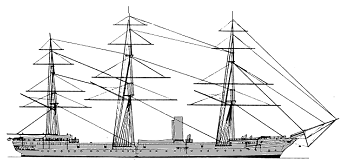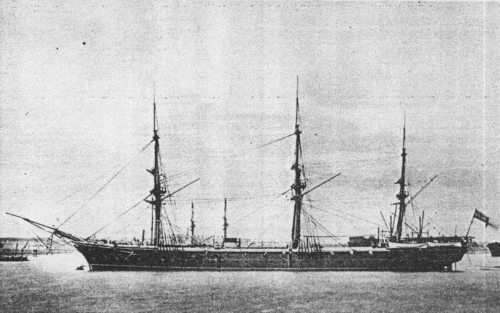

Volage 1870
| Name | No | Yard No | Builder | Laid down | Launched | Comp | Fate |
| Volage (ex-Cerberus) | Thames Iron Sbdg, Blackwall | 9.1867 | 27.2.1869 | 3.1870 | sold to BU 5.1904 | ||
| Active | Thames Iron Sbdg, Blackwall | 1867 | 13.3.1869 | 3.1871 | sold to BU 7.1906 |
|
Displacement normal, t |
3078 |
|
Displacement full, t |
|
|
Length, m |
82.3 pp |
|
Breadth, m |
12.8 |
|
Draught, m |
6.70 |
|
No of shafts |
1 (hoisting screw) |
|
Machinery |
Volage: sails + 1 2-cyl HSE trunk, 5 rectangular boilers Active: sails + 1 2-cyl HSE return connecting rod, 5 rectangular boilers |
|
Power, h. p. |
Volage: 4530 Active: 4130 |
|
Max speed, kts |
Volage: 15.3 Active: 15 |
|
Fuel, t |
coal 410 |
| Endurance, nm(kts) | 2000(10) |
|
Armament |
6 x 1 - 178/16 MLR Mk III, 4 x 1 - 160/16 64pdr 64cwt MLR |
|
Complement |
340 |
Project history: Designed by Sir Edward Reed.
The Admiralty decided to revert to the true concept of cruising ship, following
the big wood and iron frigates, by constructing a ship of half the tonnage, and
combining speed with seaworthy qualities. The result was the two handsome
corvettes Active and Volage, which epitomised all the grace of the
transitional ship. To obtain speed a hitherto unheard of ratio of length to beam
was designed, the hull cut away at below the waterline to give very fine ends,
permitting the water to have the maximum action on the rudder and thus meeting
the wishes of naval officers for high manoeuvreability. Although handling
easily, they were unsteady gun platforms, pitching deep into a head sea, and
rolling heavily in a beam sea. The latter fault was subsequently reduced by
fining large bilge keels. They were the first cruisers to steam at over 15kts.
The construction of the hull resembled that of the Inconstant, lateral
watertight bulkheads reaching up to the upper deck. The hull was encased in a
single layer of 76mm oak. These vessels had rounded sloping sterns with false
ports without quarter galleries, and had no embrasures. They both had a large
poop and topgallant forecastle rising slightly above the sheer of the 1.8m-high
waist bulwark. A patent capstan worked the cable which was led in through the
upper deck. They had double hand-wheel steering at the break of the poop.
As completed, the slide-mounted 178mm guns were carried in
the waist on broadside, and two of the truck-mounted 64pdrs were almost
amidships. The other two 64pdrs were chase guns on traversing mounts at the poop
and topgallant forecastle respectively.
They were given full ship-rig, the height of the mainmast
from deck to truck being 41.5m and the area of sail 1544m2, or about
the same area of canvas for a wooden corvette of 2000t. The best logged speeds
under canvas were 12.5kts for Active, and 13kts for Volage.
Modernizations: 1873, both: - 6 x 1 - 178/16; + 14 x 1 - 160/16 64pdr 64cwt MLR
1879, Active; 1880, Volage: - 16 x 1 - 160/16; + 10 x 1 - 152/26 BL Mk I, 2 x 1 - 76/20 12pdr 8cwt BL, 9 x 6 - 11.4/59, 2 - 356 TC
Naval service: No significant events.

Volage with funnel lowered
© Ivan Gogin, 2014